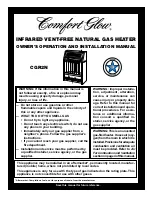
PLATINUM
WATER HEATER
25
PV500-37C 06/12
h. Replace all gaskets and seals exposed during disassembly.
i.
Reassemble unit in reverse order. Be careful when inserting hot surface ignitor, any impact is likely to
cause brakeage. Remember the burner/gasket order is:
1) Install gasket between burner and bulkhead. (align gasket openings with those in the bulkhead)
2) Insert and center burner.
3) Install second gasket over the burner flange. (Steps 1, 2, & 3 must result in the burner flange
pressed between two gaskets.)
4) Loosely attach blower over the top gasket
j.
Carefully reinsert the hot surface ignitor and loosely attach with thumb screws. (Do not touch the black
heating surface of the igniter, as oils from your hand can cause early failure. Take care, as the black
heating element is very easy to break when not properly installed.)
1) Fully tighten blower attachment nuts, then snug the hot surface ignitor thumb screws fully down
plus one quarter turn.
k. Cycle unit and test to verify all safety and operating controls are properly functioning and the flue
collector to chamber connection is free of leaks.
6.
Inspect low water cutoffs and relief valves for proper operation at every six months, or more often if
indicated by inspection.
7.
Keep appliance area clear and free from combustible materials, gasoline, other flammable vapors and
liquids.
WARNING: FIRE AND EXPLOSION HAZARD –
Can result in serious injury or death. Do not store or use
gasoline or other flammable vapors and liquids in the vicinity of this or any other appliance. Storage of
or use of gasoline or other flammable vapors or liquids in the vicinity of this or any appliance can result
in property damage, personal injury, fire, explosion, exposure to hazardous materials or death.
8.
Check frequently to be sure the flow of combustion and ventilation air to the boiler is not obstructed.
9.
All replacement parts are available through your PVI Representative or you may contact the Factory for
assistance at the address and telephone number located on the first and last page of this manual.
10.
The tank should be flushed at two- or three-month intervals depending on water conditions in your
location. To flush, turn off electrical disconnect switch to prevent the burner from operating. Open the drain
valve and allow water to flow through the tank until it runs clear. Close the drain valve and turn the
electrical switch back on. Draining two or three gallons from the bottom of the tank on a weekly basis will
also help prevent the accumulation of sediment. Water impurities consist of fine particles of soil and sand,
which will settle out and form a layer of sediment on the bottom of the tank.
11.
A scale of lime will normally form during operation and will accumulate on the bottom of the tank. Lime is
formed from naturally occurring mineral compounds in the water, which precipitate out during heating
cycles. Some water supplies contain more of these compounds than others and scale buildup will occur
more rapidly. Other factors affecting the rate of scale buildup are the amount of hot water used and the
temperature of the water. The more hot water used, the more fresh water containing scale-forming
compounds is brought into the tank. As the temperature of water increases, the rate of scale deposition
will increase.
12.
If scale is present, it can be loosened with a high-pressure stream of water. The smaller pieces can be
flushed through the drain and the larger pieces removed by hand through the removable flange. The
frequency of inspections will be determined by the rate of scale buildup. Intervals as short as 30-60 days
may be recommended in applications where scale forming conditions make it necessary.
13.
If a fire-tube leaks for any reason, consult the factory for instructions.
14.
To clean the outer plastic jacket of the PLATINUM
water heater, first remove electrical power to the unit
using the remote circuit breaker or power disconnect. Using a clean rag, clean the outer plastic jacket with
warm water containing a few drops of mild dishwashing liquid. Keep the rag moist, but not so wet that
dripping water appears. After cleaning, remove any detergent residue using a clean rag moistened with clear
water. Again, keep the rag moist, but not so wet that dripping water appears. Do not use harsh cleaners,
abrasives or stiff brushes to clean the appliance. After the unit is completely dry, restore power to the unit.







































